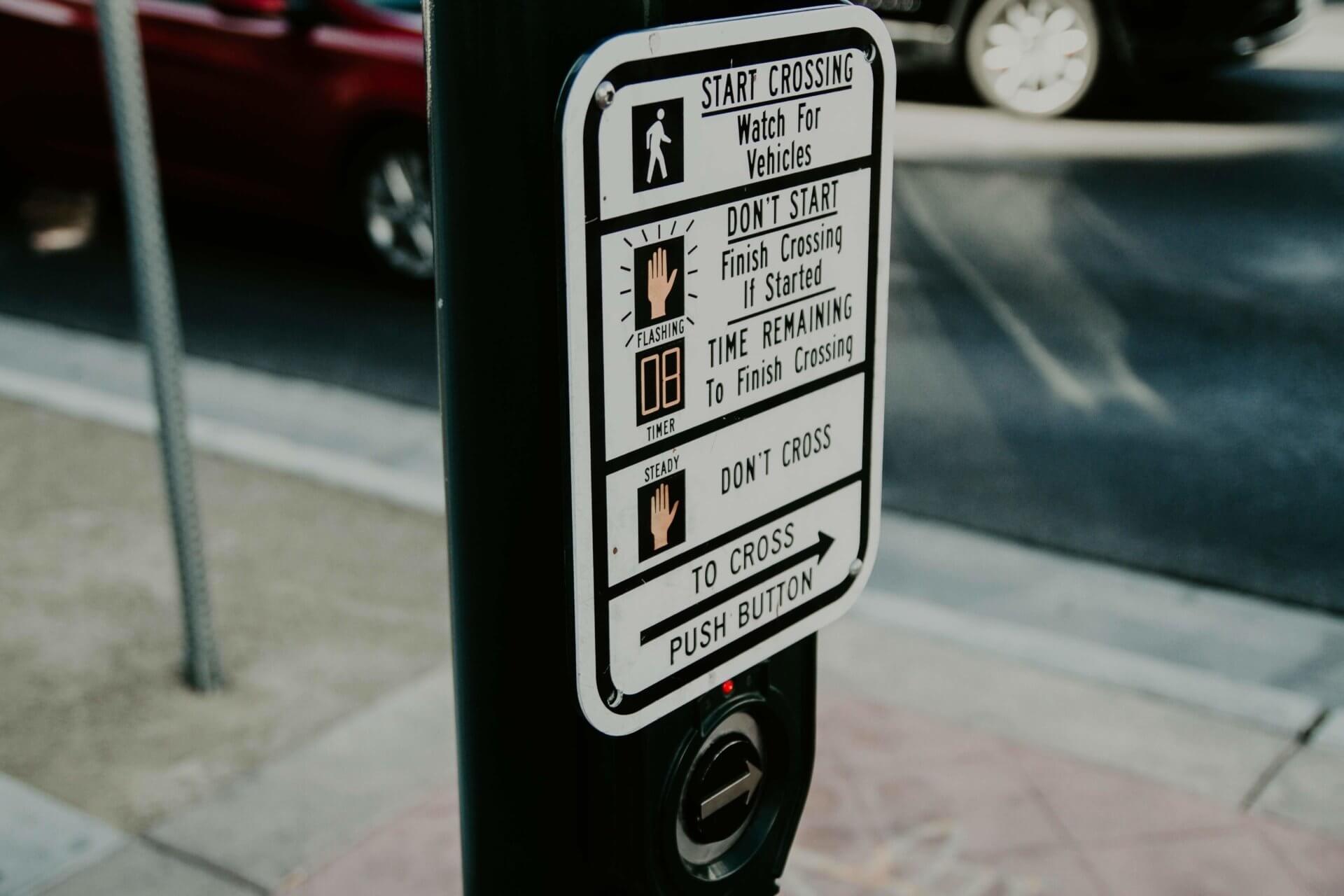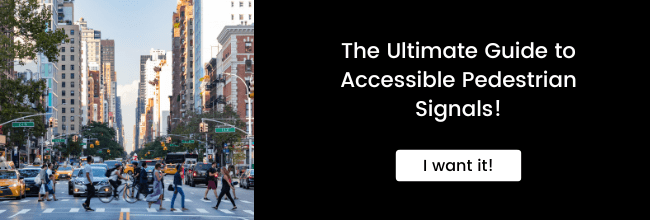
Summary
Local requirements are to install 75 new Accessible Pedestrian Signals (APS) every year in New York City. Vision Zero and Pedestrian Safety Action Plans are setting the bar even higher by planning on installing 150 new APS units per year in 2019 and 2020, doubling APS local requirement.
In compliance with the American with Disability Act of 1990 (ADA) federal standards, these new devices must equip all newly constructed intersections equipped with pedestrian signals or pedestrian facilities undergoing construction activity.
However, in practice certain criteria must be fulfilled for their implementation including requests from the blind and low-vision community, frequency of use etc.
The remaining APS installation locations provided by the law are based on engineering studies to prioritize their installation.
The Americans with Disability Act, 1990
Section 504 of the Rehabilitation Act from 1973 is one of the first American law offering protection for people with disabilities. This legislation required nondiscrimination in all programs, services, and activities receiving federal financial assistance.
In 1990, the Americans with Disability Act (ADA) for state and local governments has extended the Rehabilitation Act to newly constructed or altered public facilities regardless of the funding source.
The ADA requires these facilities to be accessible to individuals:
“Each facility or part of a facility constructed by, on behalf of, or for the use of a public entity shall be designed and constructed in such manner that the facility or part of the facility is readily accessible to and usable by individuals with disabilities, if the construction was commenced after January 26, 1992.”
All local laws must comply with ADA standards.
Proposed Accessibility Guidelines for Pedestrian Facilities in the Public Right of Way (PROWAG)
The Guidelines proposed by The Architectural and Transportation Barriers Compliance Board in 2011 play an important part in the implementation of the laws that require newly constructed and altered facilities to be accessible to individuals with the ADA.
The PROWAG ensure that “pedestrian signals, including requirements for accessible pedestrian signals and pedestrian pushbuttons’ located in the public right-of-way are readily accessible and usable by pedestrians with disabilities.”
The guidelines are the New York City Department of Transportation (NYCDOT) standards.
The National Manual on Uniform Traffic Control Devices
The National Manual on Uniform Traffic Control Devices (MUTCD) from 2009 part 4 on Highway Traffic Signals Section 4E.09 states that “The installation of accessible pedestrian signals (…) should be based on an engineering study, which should consider the following factors:
⊗ Potential demand for accessible pedestrian signals;
⊗ A request for accessible pedestrian signals;
⊗ Traffic volumes during times when pedestrians might be present;
⊗ The complexity of intersection geometry (from the pedestrian point of view);
⊗ The complexity of traffic signal phasing.
When used, accessible pedestrian signals shall be used in combination with pedestrian signal timing. The information provided by an accessible pedestrian signal shall clearly indicate which pedestrian crossing is served by each device.
Accessible pedestrian signal detectors may be pushbuttons or passive detection devices.
Accessible pedestrian signals are typically integrated into the pedestrian detector (pushbutton), so the audible tones and/or messages come from the pushbutton housing. They have a pushbutton locator tone and tactile arrow, and can include audible beaconing and other special features.
The name of the street to be crossed may also be provided in accessible format, such as Braille or raised print. Tactile maps of crosswalks may also be provided.
At accessible pedestrian signal locations where pedestrian pushbuttons are used, each pushbutton shall activate both the walk interval and the accessible pedestrian signals.
Pushbuttons for accessible pedestrian signals should be located as follows:
⊗ Adjacent to a level all-weather surface to provide access from a wheelchair, and where there is an all-weather surface, wheelchair accessible route to the ramp;
⊗ Within 1.5 m (5 ft) of the crosswalk extended;
⊗ Within 3 m (10 ft) of the ,edge of the curb, shoulder, or pavement;
⊗ Parallel to the crosswalk to be used.”
Highway Design Manual from New York State Department of Transportation
Local Highway Design Manual (HDM) from April 26, 2017 chapter 18 section 18.6.1:Pedestrian Facility Design under the Americans with Disabilities Act (ADA) states that:
“Federal regulations direct that pedestrian safety considerations, including installation of APS at street crossings be included, where appropriate.”
However, a National Cooperative Highway Research Program Project 3-62 research recognizes that the types of APS used in the United States are not entirely adequate.
Decisions to use pedestrian APS to assist blind and vision-impaired pedestrians should thus result from “effective communications” with individuals, groups, or organizations and should be based on the following:
⊗ Request(s) from blind, vision-impaired individuals or organizations that represent them,
⊗ The frequency or likelihood of use by blind or vision-impaired pedestrians,
⊗ The proximities to transit stops, government offices, medical facilities, places of employment, shopping, places that provide services to blind and/or other vision impaired persons,
⊗ Motor vehicle traffic conditions (e.g., volumes, speeds, vehicle mix, peaks, lulls, etc.), proximity to other accessible crossings,
⊗ Special, unique, or unusual conditions such as motorists’ inability to clearly see pedestrians who are waiting to cross at intersections (e.g., obstructions, curved approaches, parking lanes).
The manual also highlights the benefits to involve an Orientation and Mobility Specialist (O&M) who teaches blind and other vision-impaired pedestrians how to navigate safely and independently in the streets. These people are usually familiar with traffic control devices such as APS and can teach them how to use them.
Local laws of New York
As codified in NYC Administrative Code Section 19-188, Local Law 21 of 2012 stated that 25 intersections each year had to be equipped with new APS units. Effective in January 2016, the new Local Law 60 of 2014 now requires 75 intersections to be equipped each year. Starting in 2019, NYCDOT plans to install APS at 150 locations per year for the next 2 years, doubling APS installations annually.
New York City Administrative Code 19-188 codifies the installation of APS in the city. An Accessible Pedestrian Signals Program has been drawn up to establish the procedure to follow:
⊗ The department shall identify intersections where accessible pedestrian signals may be installed based on guidelines;
⊗ The department, after consultation with the mayor’s office for people with disabilities and with advocates for and members of the visually impaired community, shall identify intersections which reflect the greatest crossing difficulty for persons with visual impairments;
⊗ The department shall annually install, based on such guidelines, an accessible pedestrian signal at 75 intersections identified by the department following such consultation;
⊗ The department shall post on its website a report analyzing the status of the accessible pedestrian signals program;
⊗ The department shall post on its website the locations of all accessible pedestrian signals.
New York City Pedestrian Safety and Vision Zero Action Plan
In order to improve pedestrian safety in New York City, the Department of Transportation has developed a Pedestrian Safety Action Plan (PSAP) released in June 2016. The plan advises without requiring to replace non-compliant pedestrian signals with APS at intersections.
NYCDOT has issued a Traffic and Mobility Instruction 15-01 (TSMI) in June 2015 on the “Applicability of Americans with Disability Act Guidelines on Traffic Signals”. This instruction provides general direction and specific policy regarding ADA requirements at signalized intersections. Another more recent TSMI 17-02 revised in September 2017 describes the “Applicability of Americans with Disabilities Act (ADA) Guidelines to Pedestrian Safety Action Plan (PSAP) countermeasures”. The instruction states that the installation of APS is only applicable to ADA standards when the sidewalk is disturbed.
Additionality, Mayor de Blasio’s Vision Zero plan to increase pedestrian safety includes the installation of APS devices and is seeking for new technology solutions to help blind and low-vision people cross the street safely. The city has launched a Call for Innovation last year. The winner, a french-based company Okeenea will soon test its solution on the intersection of the West 23rd Stret and 7th Avenue, in Manhattan.
Are New York City crosswalks safe for blind people to cross? Find the answser in our article!
media

The ADA requires Accessible Pedestrian Signals to be accessible to all individuals
writer

Zoe Gervais
Content Manager
stay updated
Get the latest news about accessibility and the Smart City.
other articles for you

Open Data Is Key to Fostering Universal Accessibility
Open data represents an opportunity for cities to reach universal accessibility. It shows the missing links of the mobility chain.
Our Audio Beacons Guide the Blind and Visually Impaired at the Helsinki Subway
The Helsinky subway improved their audio signage system by installing on demand and remotely activated audio beacons.
7 Good Reasons to Install Audio Beacons at Your Public Transport Network
Audio beacons are an efficient way to provide more autonomy to blind and visually impaired people. They can easily use public transport.

Will Remote Activation Become the Norm for Accessible Pedestrian Signals?
More and more cities like New York have been exploring remote activation to trigger accessible pedestrian signals.
share our article!
more articles

Disability Statistics in the US: Looking Beyond Figures for an Accessible and Inclusive Society
Disability Statistics in the US: Looking Beyond Figures for an Accessible and Inclusive Society Around 61 million adults in the United States live with a disability. Diving into disability statistics in the US will help us know exactly who is concerned and what...
Our Audio Beacons Guide the Blind and Visually Impaired at the Helsinki Subway
Our Audio Beacons Guide the Blind and Visually Impaired at the Helsinki SubwayOur audio beacons equip the new line of the Helsinki subway in Finland. They help blind and visually impaired people locate the points of interest of a station. For users with visual...

Will Remote Activation Become the Norm for Accessible Pedestrian Signals?
Will Remote Activation Become the Norm for Accessible Pedestrian Signals?Without pushbutton, there are no accessible pedestrian signals. That’s how APS work in the U.S. But more and more cities have been exploring remote activation like New York City. The Department...

Hearing Impaired People: a Multitude of Profiles for Different Needs
Hearing Impaired People: a Multitude of Profiles for Different Needs Did you know that hearing impaired people have several profiles and that the way they identify themselves is important? You may be familiar with deaf and hard of hearing people but for each of...
NEVER miss the latest news about the Smart City.
Sign up now for our newsletter.
Unsubscribe in one click. The information collected is confidential and kept safe.
powered by okeenea
The French leading company
on the accessibility market.
For more than 25 years, we have been developing architectural access solutions for buildings and streets. Everyday, we rethink today’s cities to transform them in smart cities accessible to everyone.
By creating solutions ever more tailored to the needs of people with disabilities, we push the limits, constantly improve the urban life and make the cities more enjoyable for the growing majority.



